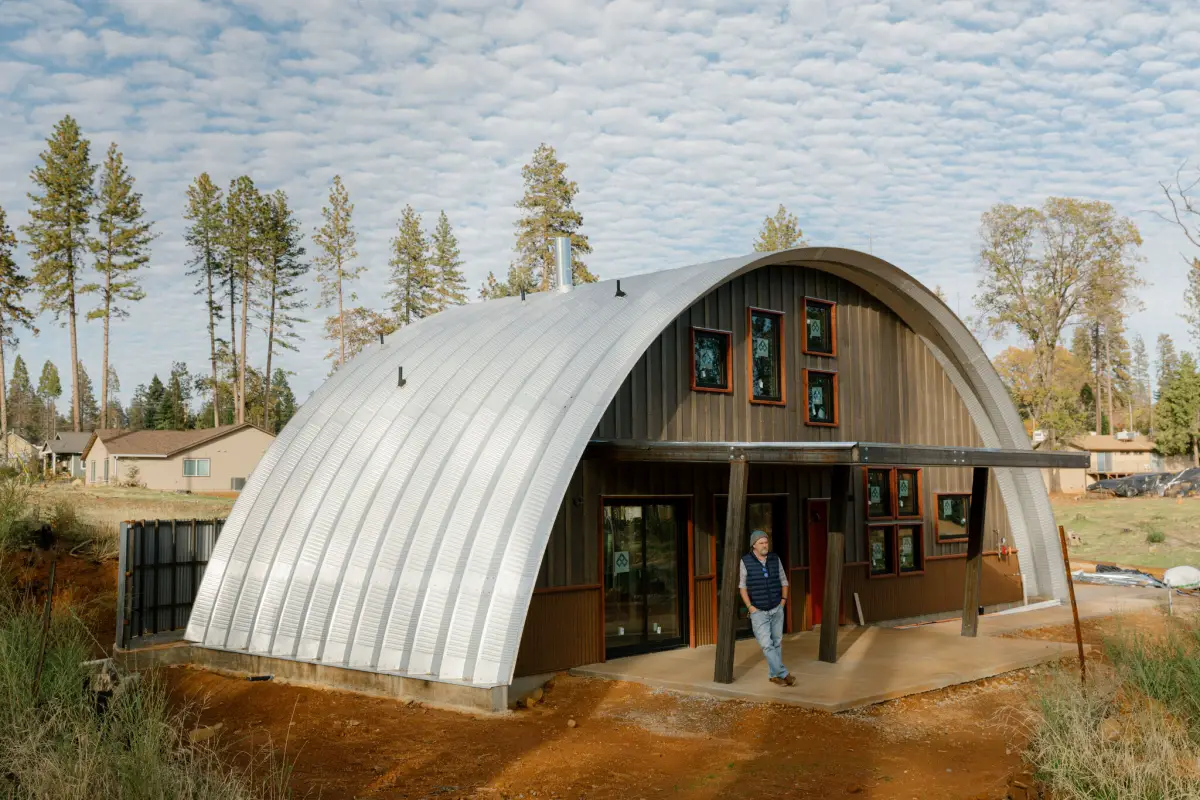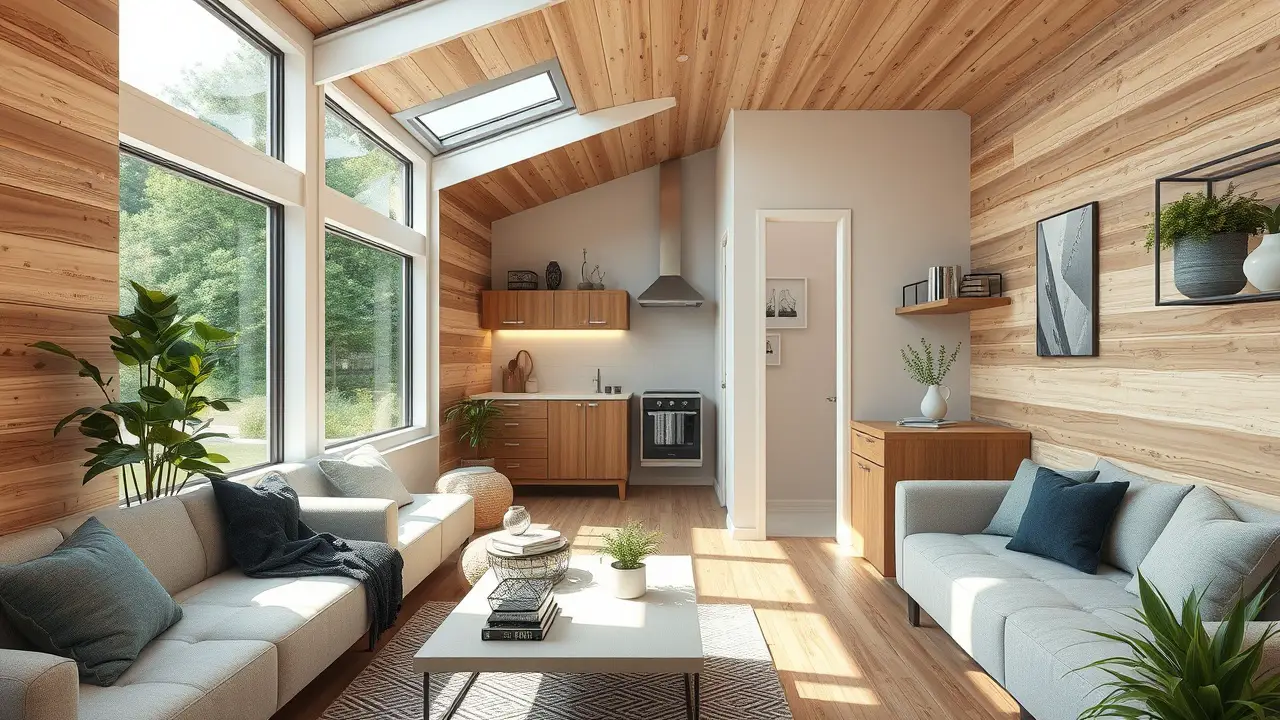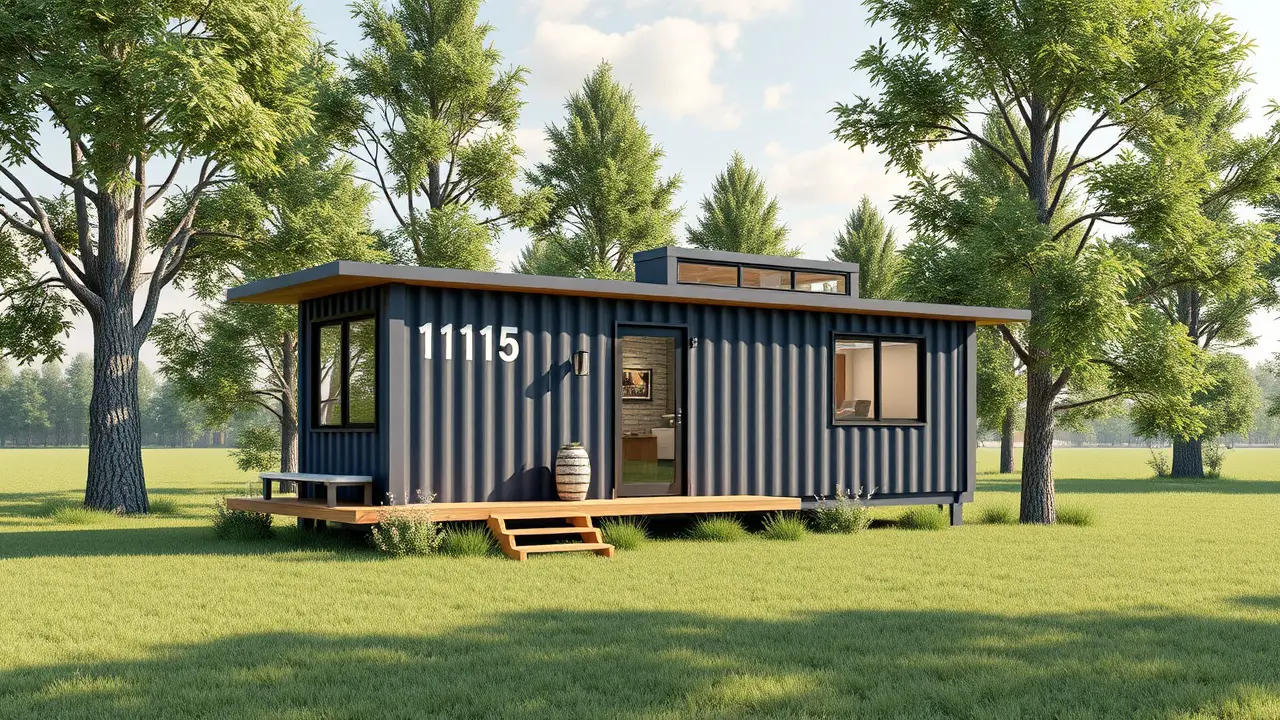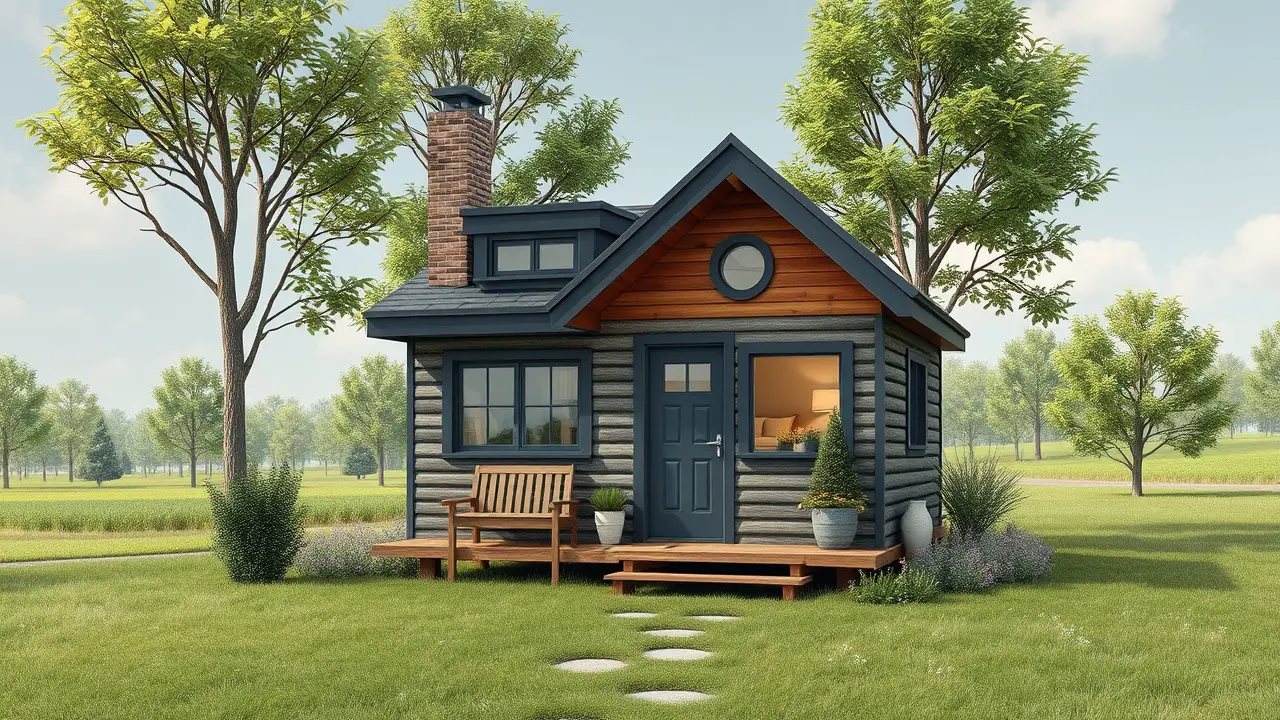Tornado proof tiny house: Buckle up, folks! We’re about to embark on a wild ride through the world of tornado-proof tiny houses.
Picture this: a cozy little abode that can withstand the fury of Mother Nature’s most ferocious twisters.
It may sound like something out of a sci-fi movie, but these resilient dwellings are very much a reality.
In tornado-prone areas, where winds can reach mind-boggling speeds and wreak havoc on traditional homes, the need for sturdy housing is paramount.
That’s where tornado-proof tiny houses come into play. These pint-sized powerhouses are designed with one goal in mind: to keep you safe when the storm clouds gather.
Now, you might be wondering what makes these tiny havens so special. Well, let me spill the beans.
First off, they’re built using cutting-edge materials and construction techniques that can withstand even the strongest gusts of wind.
Think reinforced steel frames and impact-resistant windows that laugh in the face of swirling debris.
But it’s not just about surviving a twister unscathed; there are plenty more perks to living in a tornado-proof tiny house.
Imagine never having to worry about exorbitant utility bills or spending hours cleaning rooms you hardly use.
These compact marvels offer an eco-friendly and minimalist lifestyle that’ll make your wallet and Mother Earth happy.
So, buckle up tight as we dive deeper into this fascinating world of tornado-proof tiny houses.
Get ready to be blown away by their resilience, innovation, and undeniable charm – becauseSize doesn’t matter; strength does!
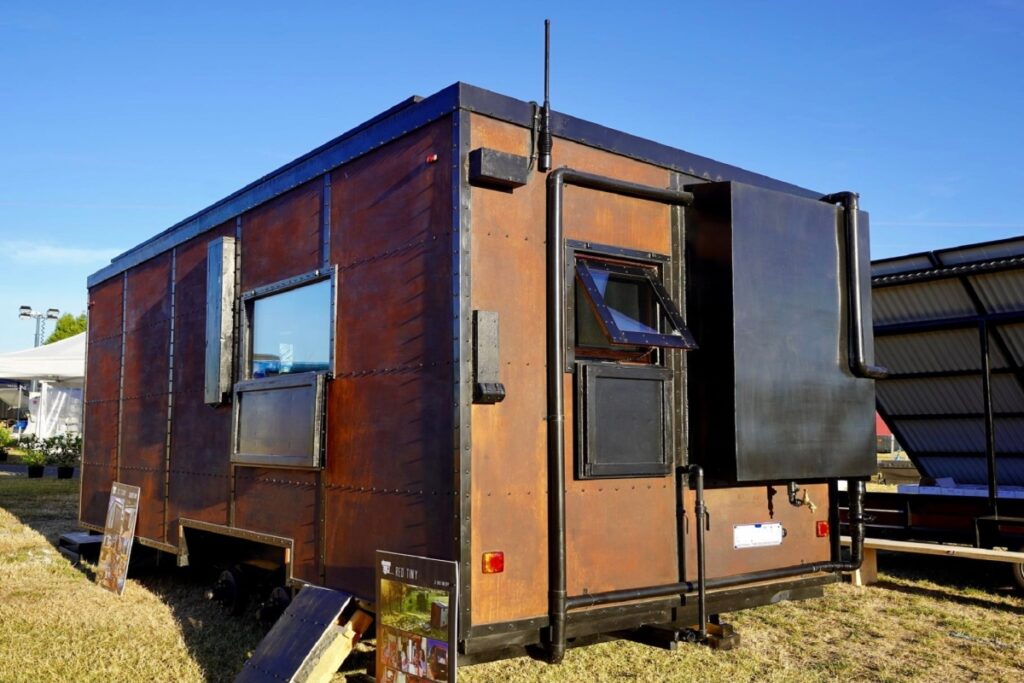
Importance of Protecting Tiny Houses from Natural Disasters
Tornadoes are powerful and destructive natural disasters that can wreak havoc on any structure in their path, and tiny houses are no exception.
These compact dwellings, often built with lightweight materials, lack the structural integrity and robustness of traditional homes.
As a result, they are particularly vulnerable to the strong winds and debris associated with tornadoes.
When a tornado strikes, it generates intense wind speeds that can easily lift or topple a tiny house if it is not properly secured.
The lightweight construction materials used in these homes may not withstand the forceful gusts, leading to significant damage or even complete destruction.
It is essential for owners of tiny houses to recognize this vulnerability and take proactive measures to protect their investment.
Risks and Damages Caused by Tornadoes
The risks posed by tornadoes extend beyond mere property damage. In addition to the financial loss incurred from repairs or rebuilding, there is also the potential for personal injury or loss of life.
Tiny houses typically have limited interior space compared to traditional homes, which means occupants may find themselves in close proximity to flying debris during a tornado event.
Moreover, the compact size of these dwellings often means they lack designated safe areas such as basements or storm shelters.
Without proper protection, residents may be left without a secure place to seek refuge during severe weather conditions.
This further emphasizes the importance of taking proactive measures to safeguard tiny houses against tornadoes.
Importance of Proactive Measures for Protection
Given the vulnerability and risks associated with tornadoes, it is crucial for owners of tiny houses to prioritize protective measures.
By taking proactive steps before disaster strikes, individuals can significantly reduce potential damages and ensure their safety during severe weather events.
One effective measure is reinforcing the structural integrity of the tiny house itself. This can involve using stronger building materials such as reinforced steel or impact-resistant glass for windows.
Securing the tiny house to a sturdy foundation or anchor points can help prevent it from being lifted or blown away by strong winds.
Another important consideration is the location of the tiny house.
Choosing a site that is less prone to tornado activity, such as avoiding areas with high tornado frequency or known tornado paths, can greatly reduce the risk of damage.
Incorporating natural barriers like trees or hills into the surrounding landscape can provide an extra layer of protection against wind forces.
Furthermore, investing in early warning systems and emergency preparedness is crucial for ensuring the safety of occupants.
Installing weather monitoring devices and subscribing to reliable weather alert services can provide valuable lead time to seek shelter before a tornado strikes.
Creating an emergency plan and practicing drills will also help residents react swiftly and effectively in case of an impending tornado.
Building Codes for Tornado-Prone Areas: What You Need to Know
It is crucial to familiarize yourself with the specific building codes and regulations in tornado-prone regions.
These guidelines are designed to ensure the safety of occupants and minimize potential damage caused by severe weather conditions.
By adhering to these regulations, you can significantly enhance the structural integrity of your tiny house.
Designing for Tornado Resistance
Designing a tornado-resistant tiny house involves careful consideration of various factors outlined by local codes.
These considerations aim to create a structure that can withstand high winds and flying debris commonly associated with tornadoes. Here are some key aspects to keep in mind:
-
Foundation: The foundation is the backbone of any structure, especially in tornado-prone areas.
-
It is essential to design a robust foundation system that can resist uplift forces exerted by strong winds. Options such as reinforced concrete or steel pilings provide excellent stability.
-
Structural Materials: Choosing suitable materials is vital for constructing a tornado-resistant tiny house.
-
Opt for materials known for their durability and ability to withstand impact, such as reinforced concrete, steel framing, or insulated concrete forms (ICFs).
-
These materials offer superior strength while minimizing vulnerability during extreme weather events.
-
Roof Design: The roof is one of the most vulnerable parts of any building.
-
To enhance its resistance, consider using metal roofing or impact-resistant shingles that meet local building code requirements. Designing a roof with a steep pitch can help reduce wind uplift forces.
-
Windows and Doors: Windows and doors are susceptible points where wind pressure can enter a structure during a tornado event.
-
Installing impact-resistant windows made from laminated glass or polycarbonate material provides added protection against debris impact. Reinforced doors equipped with heavy-duty locks and hinges are also essential.
-
Anchoring Systems: Properly anchoring the tiny house to its foundation is crucial for withstanding tornado-force winds.
-
Utilize anchor bolts or straps that meet local code requirements to secure the structure firmly. These anchoring systems help prevent uplift and lateral movement during severe weather events.
Importance of Building Code Compliance
Adhering to building codes is not just a legal requirement; it plays a significant role in enhancing safety and minimizing damage caused by tornadoes. Here’s why building code compliance is crucial:
-
Structural Integrity: Building codes are developed based on extensive research, engineering principles, and lessons learned from past tornado events.
-
By following these guidelines, you ensure that your tiny house possesses the necessary structural integrity to withstand high wind speeds and flying debris.
-
Safety of Occupants: The primary purpose of building codes is to protect occupants from harm during severe weather conditions.
-
Compliance with these regulations helps create a safe living environment by minimizing the risk of structural failure and ensuring proper egress routes in case of emergencies.
-
Insurance Coverage: Insurance companies often require proof of compliance with local building codes when providing coverage for properties in tornado-prone areas.
-
By meeting these requirements, you can ensure that your tiny house is eligible for comprehensive insurance coverage in case of tornado-related damages.
-
Resale Value: A well-built tiny house that adheres to building codes will have higher resale value compared to structures without proper compliance.
-
Prospective buyers are more likely to invest in a property that provides enhanced safety features and has been constructed according to established standards.
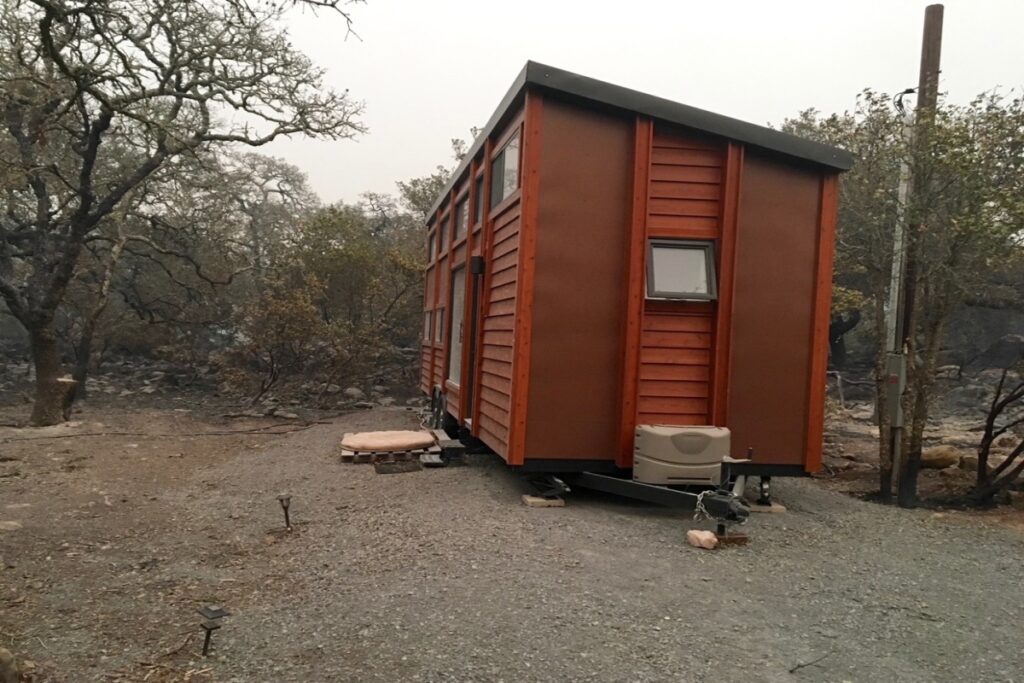
Severe Weather Preparation for Your Tiny House: A Checklist
One of the first things you should do is secure any loose items that could become projectiles during a tornado.
These can include outdoor furniture, planters, and even lightweight structures like awnings or sheds.
Use sturdy straps or tie-downs to secure these items to prevent them from being blown away. Creating an emergency kit is also crucial in ensuring your safety during a tornado.
The kit should contain essential items such as non-perishable food, bottled water, a first aid kit, flashlights with extra batteries, blankets, and a portable weather radio.
It’s important to regularly check and replenish the supplies in your emergency kit so that they are always up-to-date.
Reinforce Windows and Doors
To make your tiny house more tornado-proof, reinforcing windows and doors is vital. Consider installing impact-resistant windows or adding storm shutters for added protection against high winds and flying debris.
Reinforcing entry doors with heavy-duty hinges and deadbolts can also increase their resistance to strong winds.
Sealing any gaps around windows and doors will help prevent wind-driven rain from entering your tiny house during a storm.
Weatherstripping can be used to seal these gaps effectively. Remember that every vulnerable point in your tiny house’s structure increases the risk of damage during severe weather events.
Trim Nearby Trees
In the event of a tornado, nearby trees pose a significant threat to your tiny house if they are not properly maintained.
Overhanging branches can break off during high winds and cause severe damage to the roof or walls of your home-on-wheels.
Inspect the trees surrounding your property regularly and trim any overhanging branches that could potentially reach your tiny house in case of strong gusts.
If you’re uncertain about how to safely trim trees yourself, it’s best to hire a professional arborist who can ensure the job is done correctly.
Have a Communication Plan
Having a well-thought-out communication plan is essential for staying connected with loved ones during severe weather.
Make sure everyone in your tiny house knows where to gather in case of an emergency and establish a designated out-of-state contact person.
This individual can act as a central point of communication for family members or friends outside the affected area.
Consider investing in a reliable two-way radio or walkie-talkies that you can use to communicate with others if cell phone service becomes unavailable during or after a tornado.
It’s also wise to have backup power sources, such as portable generators or solar panels, to keep your communication devices charged.
Ensuring Your Tiny House is Tornado-Ready
There are several steps you need to take. By following this checklist and implementing these measures, you can significantly increase the chances of protecting yourself and your home from severe weather events.
Remember, securing loose items and creating an emergency kit are crucial first steps. Reinforcing windows and doors will provide added protection against high winds and flying debris.
Trimming nearby trees reduces the risk of damage caused by falling branches. Lastly, having a communication plan ensures that you stay connected with loved ones during an emergency.
By taking these precautions seriously and being prepared for severe weather, you can enjoy peace of mind knowing that your tornado-proof tiny house is ready for whatever nature throws its way. Stay safe!
Wind-Resistant Tiny House Designs: Features to Look For
It’s crucial to identify the essential design features that can make a significant difference in withstanding high winds.
These features not only ensure the safety of the occupants but also protect the structural integrity of the house itself.
-
Aerodynamic Shapes: One key element of a wind-resistant tiny house is its shape. Opting for an aerodynamic design helps reduce wind resistance and prevents strong gusts from exerting excessive force on the structure.
-
Consider rounded edges, sloping roofs, and streamlined profiles when selecting or designing your tiny home.
-
Reinforced Structures: To withstand powerful winds, it’s important to reinforce the overall structure of your tiny house.
-
This includes using sturdy materials such as reinforced steel framing or engineered wood products like laminated beams.
-
Reinforcements should be strategically placed throughout the construction to distribute forces evenly and minimize potential damage.
Techniques for Enhanced Wind Resistance
Now that we’ve discussed essential design features, let’s delve into some specific techniques that can enhance wind resistance in a tornado-proof tiny house.
-
Strategic Window Placement: Windows are vulnerable points during high winds, so their placement plays a crucial role in wind resistance.
-
Consider locating windows away from prevailing wind directions or use impact-resistant glazing materials like laminated glass or polycarbonate panels.
-
Installing shutters or storm-rated window coverings provides an extra layer of protection against flying debris.
-
Sturdy Roofing Materials: The roof is another critical aspect. Opt for roofing materials with high wind ratings such as metal panels or asphalt shingles designed specifically for hurricane-prone areas.
-
Ensure proper installation techniques are followed, including secure fastening systems and adequate bracing.
-
Secure Anchoring Systems: A robust anchoring system is essential to keep your tiny house rooted during severe storms.
-
Consider using helical or screw-in ground anchors that provide excellent resistance against uplift forces.
-
Tying down the house to a concrete foundation or using heavy-duty straps and cables can further enhance stability.
Prioritizing Wind-Resistant Designs
-
Safety First:Safety should always be the top priority. Investing in wind-resistant features ensures the well-being of occupants by minimizing risks associated with high winds and flying debris. Don’t compromise on safety when making decisions about your tiny home’s design.
-
Long-Term Cost Savings: While wind-resistant features may entail additional upfront costs, they can lead to long-term savings by reducing potential damage from severe weather events.
-
By incorporating these design elements into your tiny house, you’ll minimize repair expenses and enjoy peace of mind knowing that your home is built to withstand nature’s fury.
-
Peaceful Living Environment: A wind-resistant tiny house provides a more peaceful living environment during storms.
-
With reinforced structures and secure anchoring systems in place, you can rest assured that your home will remain stable even in gusty conditions.
-
This peace of mind allows you to focus on other aspects of life without worrying about the integrity of your dwelling.

Earth-Sheltered Tiny Homes: A Natural Tornado Protection
Living in tornado-prone areas can be nerve-wracking, but what if there was a way to naturally protect yourself from these destructive forces of nature?
Enter earth-sheltered tiny homes – an innovative solution that combines sustainable living with built-in tornado protection.
By exploring the advantages of these unique dwellings, we uncover their ability to shield occupants from the wrath of tornadoes.
Insulation That Goes Beyond Expectations
One of the key reasons why earth-sheltered homes excel in tornado protection is their exceptional insulation properties.
These dwellings are partially or entirely buried into the ground, providing natural thermal stability and reducing wind exposure.
The surrounding soil acts as a natural insulator, regulating temperature fluctuations and minimizing heat loss during winter months.
As a result, the interior remains comfortably warm even when fierce winds howl outside.
Building Strength from Beneath
In addition to their insulation benefits, earth-sheltered tiny homes boast increased structural strength compared to traditional above-ground houses.
The combination of being nestled within the earth and utilizing reinforced materials creates a robust shelter capable of withstanding intense winds.
While conventional houses may succumb to high-speed gusts and flying debris, these subterranean havens remain steadfast against nature’s fury.
To further enhance structural integrity, builders often incorporate reinforced concrete walls and roofs into earth-sheltered designs.
This ensures that even under extreme pressure caused by tornado-force winds, the dwelling maintains its shape and protects its inhabitants.
By harnessing the power of solid construction techniques and leveraging natural surroundings, these tiny homes become formidable fortresses against turbulent weather conditions.
A Match Made in Design Heaven
When considering building a tiny house that can withstand tornadoes, incorporating earth-sheltered elements into your design becomes paramount.
The beauty of this approach lies not only in its protective capabilities but also in the seamless integration of sustainable living principles.
By blending into the natural landscape, earth-sheltered tiny homes harmonize with their surroundings while providing a safe haven for occupants.
To maximize tornado protection, architects and builders can employ various strategies when designing these unique dwellings. Here are some notable techniques:
-
Berming: Creating an earth berm around the exterior walls of the home helps to shield it from high winds and flying debris.
-
Sloping Roofs: Designing roofs with gentle slopes reduces wind resistance, preventing uplift during tornadoes.
-
Reinforced Walls: Using reinforced concrete or other strong building materials for walls enhances structural stability.
-
Natural Ventilation Systems: Incorporating ventilation systems that utilize natural airflow reduces reliance on electricity and promotes eco-friendly living.
By thoughtfully integrating these features into your tiny house design, you not only increase its ability to withstand tornadoes but also create an environmentally conscious dwelling that embraces sustainable practices.
Hurricane-Resistant Prefab House Kits for Tornado Zones
There’s no room for compromise. That’s why we’re thrilled to introduce our revolutionary hurricane-resistant prefab house kits.
Specially designed to withstand the fury of hurricanes while also providing unparalleled protection against tornadoes.
These innovative kits are a game-changer in the world of tiny houses, offering peace of mind and safety without sacrificing style or comfort.
Reinforced Walls: The First Line of Defense
One of the key features that sets our tornado-proof tiny houses apart is their reinforced walls. Built with state-of-the-art materials, these walls are engineered to withstand extreme winds and flying debris.
Our experts have carefully selected high-quality materials that provide exceptional strength and durability without compromising on aesthetics.
From fiber cement panels to insulated concrete forms (ICFs), these walls offer superior protection against tornadoes and hurricanes alike.
To ensure maximum safety, our prefab house kits incorporate advanced construction techniques such as interlocking wall systems and steel framing.
These methods not only enhance structural integrity but also minimize the risk of damage caused by lateral forces during severe weather events.
By investing in our tornado-proof tiny houses, you can rest easy knowing that you’ve taken proactive measures to safeguard your loved ones and possessions.
Impact-Resistant Windows: Keeping Danger at Bay
Windows are often vulnerable points during severe storms, allowing wind pressure to enter a structure and potentially causing catastrophic damage.
However, our hurricane-resistant prefab house kits feature impact-resistant windows that are specifically designed to withstand high-speed projectiles commonly associated with tornadoes and hurricanes.
These windows utilize laminated glass technology combined with robust frames made from durable materials like vinyl or aluminum.
In addition to their incredible strength, these impact-resistant windows offer other benefits too. They provide excellent insulation properties, reducing energy consumption by minimizing heat transfer.
Moreover, they are also effective in reducing outside noise, creating a peaceful and comfortable living environment.
With our tornado-proof tiny houses, you can enjoy both safety and serenity without compromise.
Durable Roofing Materials: A Solid Shield Above
The roof is perhaps the most critical component of any structure. That’s why our prefab house kits feature roofing materials that are specifically chosen for their exceptional durability and resistance to tornadoes and hurricanes.
From metal roofs to impact-resistant shingles, these materials provide an impenetrable shield against the elements.
Metal roofs are particularly popular among those seeking ultimate protection. They offer exceptional wind resistance, preventing uplift during high-speed winds associated with tornadoes and hurricanes.
Metal roofs have a long lifespan, require minimal maintenance, and are fire-resistant—an added advantage in areas prone to wildfires.
For those who prefer a more traditional look, impact-resistant shingles are an excellent choice.
These shingles are specially designed to withstand strong winds and impacts from debris without compromising on aesthetics.
Available in various styles and colors, they allow homeowners to personalize their tornado-proof tiny houses while ensuring optimal protection.
The Convenience of Prefab Kits: Building Your Safe Haven
In addition to their outstanding safety features, our hurricane-resistant prefab house kits offer unmatched convenience and efficiency when constructing your tornado-proof tiny house.
These kits come with pre-cut components that fit together seamlessly like pieces of a puzzle—eliminating the need for time-consuming measurements or intricate carpentry work.
By opting for a prefab kit, you can save significant time and effort during the construction process.
Whether you choose to build it yourself or hire professionals for assistance, the streamlined nature of these kits ensures swift progress without compromising on quality or safety standards.
Furthermore, prefab house kits often include comprehensive assembly instructions that guide you through each step of the construction process.
With clear diagrams and easy-to-understand language, these instructions make building your tornado-proof tiny house a breeze—no prior construction experience required.
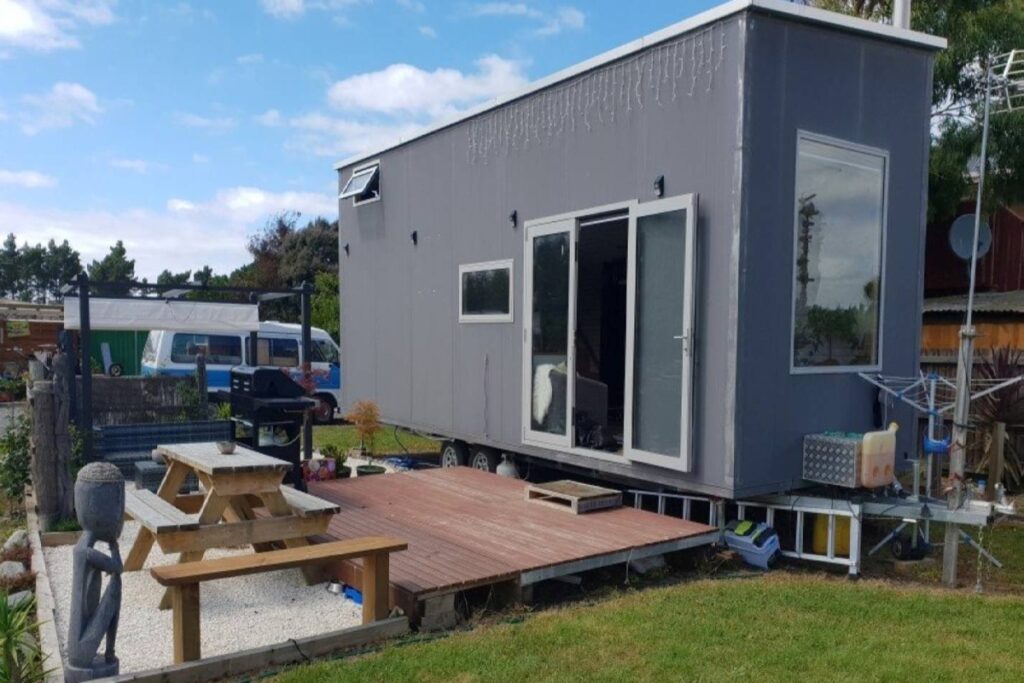
Tornado-Proof Building Materials for Tiny Houses
Concrete has long been recognized as a sturdy and reliable building material, andReinforced concrete is an excellent choice.
This material consists of regular concrete mixed with steel reinforcement, creating a powerful combination that can withstand even the most severe tornadoes.
Reinforced concrete offers exceptional structural integrity due to its ability to distribute loads evenly across its surface.
This means that during a tornado, the force exerted on the walls and roof of your tiny house will be spread out more effectively, reducing the risk of collapse.
Reinforced concrete is highly resistant to fire, mold, and pests, making it an ideal choice for those seeking durability in their tornado-proof tiny homes.
The Strength of Steel Frames
Another popular option for constructing tornado-proof tiny houses is using steel frames.
Steel is known for its incredible strength and resilience, making it an excellent choice for areas prone to severe weather conditions like tornadoes.
A steel frame provides a robust structure that can withstand high winds and flying debris.
Steel frames offer several advantages over traditional wood frames commonly used in construction. Firstly, they are non-combustible and provide enhanced fire resistance compared to wood.
Secondly, steel does not rot or warp like wood does over time, ensuring long-lasting durability for your tiny house. Lastly, steel frames require minimal maintenance compared to other materials.
Choosing Appropriate Building Materials
There are several factors you should consider:
-
Strength: Opt for materials with high tensile strength that can withstand extreme wind forces.
-
Durability: Look for materials that are resistant to damage from impacts or flying debris.
-
Fire Resistance: Consider materials that offer enhanced fire resistance properties.
-
Maintenance: Choose low-maintenance materials that require minimal upkeep over time.
-
Cost: Evaluate the cost-effectiveness of different materials, considering both upfront and long-term expenses.
While reinforced concrete and steel frames are excellent options, there are other tornado-resistant materials worth exploring.
For example, fiber cement siding provides superior durability and is resistant to fire, moisture, and pests.
Impact-resistant windows can protect your tiny house from debris during a tornado while offering energy efficiency benefits.
Remember to consult with professionals experienced in building tornado-proof structures to ensure you make the best choices for your tiny house’s construction.
By selecting the right materials, you can significantly increase the safety and resilience of your home against tornadoes.
Structural Engineering for Tornado-Proof Tiny Houses: Key Considerations
Building a tornado-proof tiny house requires careful consideration of its load-bearing capacity and wind uplift resistance.
It’s crucial to ensure that the structure can withstand the powerful forces exerted by a tornado.
The foundation is of utmost importance. A sturdy foundation provides the necessary support to hold up the entire structure during extreme weather conditions.
Reinforced concrete footings or pilings are commonly used to anchor tiny houses securely. In addition to a strong foundation, the framing system should be designed with resilience in mind.
Using durable materials such as steel or engineered wood can enhance the load-bearing capacity of your tiny house.
These materials have high strength-to-weight ratios, making them ideal for withstanding tornado forces.
To further fortify your tiny house against tornadoes, wind uplift resistance is crucial. This refers to the ability of your structure to resist being lifted off its foundation by strong winds.
Properly securing your roof and walls is essential in preventing catastrophic damage during a tornado.
One effective technique for enhancing wind uplift resistance is using hurricane straps or metal connectors between the walls and roof trusses.
These connectors help distribute the force evenly throughout the structure, reducing vulnerability to uplift.
Professional Consultation During Design Phase
To ensure optimal structural integrity, consulting with professionals during the design phase of your tornado-proof tiny house is highly recommended.
Structural engineers possess expertise in analyzing loads and designing structures that can withstand severe weather events like tornadoes.
During these consultations, engineers will evaluate factors such as local building codes, site-specific conditions (e.g., soil type), and potential wind speeds in your area.
They will provide valuable insights into designing an efficient and robust structure tailored specifically for your location.
Professional consultation also allows you to address any concerns regarding material selection, construction techniques, and overall safety measures.
By leveraging their knowledge and experience, you can gain peace of mind knowing that your tiny house is designed to withstand tornadoes.
Proper Reinforcement Techniques in Critical Areas
Focusing on proper reinforcement techniques in critical areas is essential. These areas include the roof, doors, windows, and connections between different structural components.
Starting with the roof, it should be constructed using impact-resistant materials such as metal or reinforced shingles.
Implementing a steep pitch design helps reduce wind resistance and prevents uplift. Reinforcing the roof trusses with hurricane straps or metal connectors enhances its overall strength.
Doors and windows are particularly vulnerable during tornadoes due to the high wind pressures they face.
Installing impact-resistant doors made of solid wood or fiberglass can help mitigate damage caused by flying debris.
Similarly, using laminated glass for windows significantly reduces the risk of breakage during severe storms.
Ensuring strong connections between different parts of your tiny house is crucial for overall stability.
Using anchor bolts or strap ties to secure wall framing to the foundation provides added strength against lateral forces exerted by tornado winds.
In critical junctions where walls meet roofs or floors, employing additional bracing techniques like shear walls can further enhance structural integrity.
These walls act as reinforcements against lateral loads and distribute forces more evenly throughout the structure.
Remember that while these key considerations are important for building a tornado-proof tiny house, no structure can guarantee complete safety in all circumstances.
It’s always recommended to stay informed about local weather conditions and have an emergency plan in place to protect yourself during severe storms.
By carefully considering load-bearing capacity, wind uplift resistance, seeking professional consultation during the design phase.
And implementing proper reinforcement techniques in critical areas, you can significantly increase the resilience of your tiny house against tornadoes.
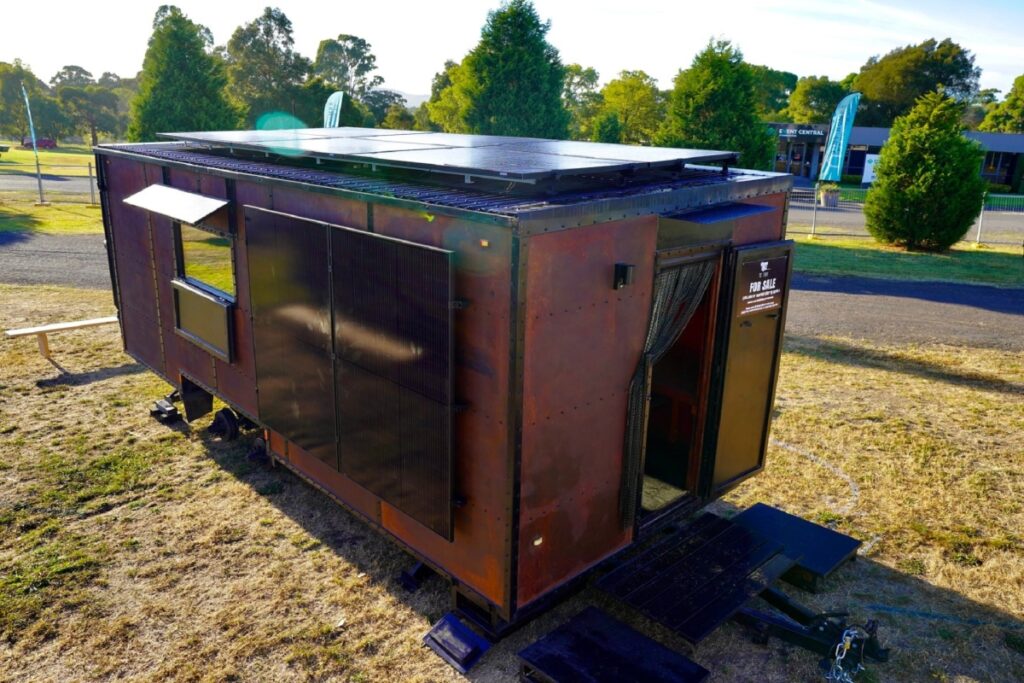
Retrofitting Existing Tiny Houses for Tornado Resistance: A Step-by-Step Guide
Inspect and strengthen the existing foundation:
-
Look for any signs of cracks or weaknesses in the foundation. These can be indicators of potential vulnerabilities during a tornado.
-
Consult with a structural engineer to assess the foundation’s integrity and identify areas that require reinforcement.
-
Implement recommended measures such as adding additional concrete supports, installing steel brackets, or reinforcing with carbon fiber strips.
-
Bolstering the walls:
-
Use anchor bolts to secure the walls to the foundation more effectively.
-
Consider installing reinforced concrete panels or using materials like insulated concrete forms (ICFs) that offer greater structural strength.
-
Apply an extra layer of protection by adding exterior sheathing made from impact-resistant materials such as fiber cement or metal siding.
-
Strengthening roof structures:
-
Evaluate the current roof system’s ability to withstand high winds and flying debris.
-
Reinforce trusses or rafters with hurricane straps or metal connectors to enhance their resistance against uplift forces.
-
Opt for impact-resistant roofing materials like metal, clay tiles, or asphalt shingles designed specifically for high-wind zones.
-
Adding Storm Shutters or Impact-Resistant Windows: Protecting Vulnerable Openings
Installing storm shutters:
-
Choose from various types of storm shutters, including accordion-style, roll-down, or panel shutters.
-
Ensure that shutters meet local building code requirements and are capable of withstanding wind speeds associated with tornadoes in your area.
-
Properly install and secure shutters over windows and doors before severe weather strikes.
-
Upgrading to impact-resistant windows:
-
Replace existing windows with impact-resistant ones designed to withstand strong winds and flying debris.
-
Look for windows certified by recognized organizations such as the American Architectural Manufacturers Association (AAMA) or the Miami-Dade County Product Control Division.
-
Consider laminated glass or polycarbonate glazing systems that provide enhanced protection without sacrificing natural light.
-
Strengthening Structural Integrity: Going Beyond the Basics
Reinforcing doors:
-
Replace lightweight doors with solid wood, metal, or fiberglass doors that offer greater strength and resistance to wind pressure.
-
Install heavy-duty hinges and secure door frames with additional bracing to prevent them from being blown open during a tornado.
-
Securing loose objects:
-
Identify potential hazards inside and outside your tiny house, such as furniture, appliances, or outdoor equipment that could become airborne during a tornado.
-
Anchor heavy items securely to walls or floors using straps or brackets.
-
Store smaller objects in cabinets or drawers to minimize their movement during high winds.
-
Enhancing interior safety features:
-
Create a designated safe room within your tiny house where you can seek shelter during a tornado.
-
Reinforce this area by installing additional wall studs, using impact-resistant materials for walls and ceilings, and reinforcing the door with sturdy locks and hinges.
-
Throughout the Retrofitting Process:
-
Consult with professionals: Seek guidance from structural engineers, contractors experienced in storm-resistant construction, or local building officials who can provide valuable insights into specific requirements for your area.
-
Follow local building codes: Ensure that all retrofitting measures comply with local building codes and regulations to guarantee maximum safety standards are met.
-
Regular maintenance: Conduct periodic inspections of your retrofitted tiny house to identify any signs of wear and tear. Address issues promptly to maintain its integrity against future storms.
By following these step-by-step guidelines for retrofitting existing tiny houses, you can significantly enhance their tornado resistance.
Remember, investing in these measures not only protects your property but also ensures the safety of you and your loved ones when severe weather strikes. Stay prepared and stay safe!
Proper Anchoring Techniques for Tornado-Proof Tiny Houses
Proper anchoring techniques are essential. With the right methods in place, you can significantly increase the chances of your tiny house remaining intact during a tornado.
Let’s delve into some of the most effective anchoring options available.
Ground Anchors: A Solid Foundation
One popular option for securing a tornado-proof tiny house is using ground anchors.
These sturdy devices are driven deep into the ground and provide excellent resistance against strong winds. Ground anchors come in various designs, including screw-in and auger-style anchors.
Screw-in ground anchors are twisted directly into the soil using a wrench or drill with an appropriate attachment.
They offer exceptional holding power due to their threaded design, making them ideal for areas with soft soil or sandy terrain.
On the other hand, auger-style ground anchors feature helical blades that dig into the ground as they are turned clockwise. This type of anchor is more suitable for compacted soils or clay-based grounds.
Concrete Footings: A Reliable Option
Another anchoring technique commonly used for tornado-proof tiny houses is concrete footings.
Concrete footings involve pouring concrete pads beneath each corner of your tiny house to provide stability and prevent uplift during high winds.
To install concrete footings, begin by excavating holes at least three feet deep at each corner of your tiny house’s foundation.
Next, place rebar reinforcement within each hole to enhance strength and durability. Finally, pour concrete into the holes and allow it to cure fully before placing your tiny house on top.
Concrete footings offer several advantages. They provide a solid foundation that can withstand powerful winds while also offering protection against other natural disasters such as flooding.
Specialized Tie-Down Systems: Maximum Security
For those seeking maximum security, specialized tie-down systems are an excellent choice.
These systems consist of heavy-duty straps or cables that connect the tiny house to ground anchors or concrete footings, ensuring it remains firmly in place during tornadoes.
Tie-down systems typically involve wrapping straps or cables around the frame of the tiny house and securing them to anchor points embedded in the ground.
The straps should be tightened to provide adequate tension while still allowing some flexibility for natural movement during high winds.
It’s important to note that tie-down systems require proper installation and regular maintenance to ensure their effectiveness.
Regularly inspect the straps or cables for signs of wear and tear, and replace any damaged components promptly.
The Importance of Proper Installation and Regular Maintenance
Proper installation and regular maintenance cannot be stressed enough. Regardless of which anchoring method you choose, following these guidelines is crucial for maximizing your tiny house’s safety:
-
Consult with Experts: Before installing any anchoring system, consult with experts familiar with local building codes and regulations specific to tornado-prone areas.
-
They can provide valuable insights and guidance on the most suitable options for your location.
-
Follow Manufacturer Guidelines: Whether using ground anchors, concrete footings, or specialized tie-down systems, always follow the manufacturer’s instructions carefully during installation.
-
This ensures that you achieve optimal results and maintain compliance with safety standards.
-
Regular Inspections: Conduct regular inspections of your anchoring system at least once a year or after severe weather events.
-
Look for signs of damage such as rusting, fraying, or loosening connections. Promptly address any issues by repairing or replacing components as necessary.
-
Reinforcement Where Needed: Consider reinforcing vulnerable areas of your tiny house against strong winds by adding additional support beams or bracing techniques within the structure.
-
This extra reinforcement can further enhance the resilience of your tiny house during tornadoes.
By implementing proper installation techniques, choosing the right anchoring method for your specific location, and conducting regular maintenance.
You can significantly increase the chances of your tornado-proof tiny house remaining secure even in the face of severe weather conditions.
Remember, investing time and effort into ensuring the safety of your tiny house is a small price to pay for peace of mind knowing that you have taken every possible precaution to protect yourself and your home from destructive tornadoes.

Building a Safe and Secure Tornado-Proof Tiny House
There are several key elements and considerations that homeowners should keep in mind.
By combining proper design, construction techniques, and materials, you can create a safe and secure space that can withstand the powerful forces of a tornado.
-
Foundation: The foundation is the backbone of any structure, especially. Opt for a reinforced concrete slab or piers anchored deep into the ground to provide stability during high winds.
-
Structural Design: The design of your tiny house plays a crucial role in its ability to withstand tornadoes.
-
Consider consulting with an engineer who specializes in storm-resistant structures to ensure your design meets safety standards.
-
Roofing: A strong roof is essential in protecting your tiny house from tornado damage. Install hurricane straps or metal connectors to reinforce the connection between the roof trusses and walls.
-
Opt for impact-resistant roofing materials such as metal or asphalt shingles rated for high wind speeds.
-
Walls: Choose sturdy materials for your walls that can withstand strong winds and flying debris.
-
Concrete blocks or insulated concrete forms (ICFs) offer excellent resistance against extreme weather conditions.
-
Windows and Doors: Reinforce windows and doors with impact-resistant glass or install storm shutters to protect against flying debris during a tornado. Consider using multiple locking mechanisms for added security.
-
Anchoring Systems: Securely anchor your tiny house to its foundation using appropriate anchoring systems such as steel cables or tie-down straps designed specifically for high-wind areas.
-
Ventilation: Incorporate proper ventilation systems into your tiny house design to prevent pressure buildup during severe storms or tornados.
Importance of Safety Measures Throughout the Building Process
Building a safe and secure tornado-proof tiny house requires homeowners to prioritize safety measures at every stage of the construction process. Here’s why it’s crucial to pay attention to these measures:
-
Prevention of Life-Threatening Situations: Tornadoes can cause significant damage and pose a serious threat to human life.
-
By implementing safety measures from the beginning, you can reduce the risk of injury or loss of life for yourself and your loved ones.
-
Protection of Property: A tornado-proof tiny house not only safeguards its occupants but also protects valuable belongings.
-
By investing in proper design, construction, and materials, you can minimize property damage caused by severe weather events.
-
Peace of Mind: Knowing that your tiny house is built to withstand tornadoes provides peace of mind during stormy weather conditions.
-
You can rest assured that your home is a safe haven where you and your family can seek shelter without fear.
-
Long-Term Cost Savings: While building a tornado-proof tiny house may require some upfront investment, it can result in long-term cost savings by mitigating potential damage from severe weather events.
-
Repairing or rebuilding after a tornado can be costly, making prevention an economically wise decision.
Conclusion
Building a tornado-proof tiny house is of utmost importance. Understanding the building codes specific to tornado-prone areas is crucial.
By adhering to these regulations, you can ensure that your tiny house is constructed with the necessary reinforcements and structural elements to withstand high winds and flying debris.
Preparing for severe weather is essential for any homeowner, especially those living in tornado zones.
We have provided you with a comprehensive checklist that covers everything from securing loose items to having an emergency plan in place.
When choosing a wind-resistant tiny house design, it’s important to look for features such as reinforced windows, impact-resistant materials, and aerodynamic shapes.
These design elements help minimize damage during a tornado event.
For those seeking natural protection against tornadoes, earth-sheltered tiny homes offer an innovative solution.
By leveraging the insulating properties of soil, these homes provide excellent resistance against high winds while offering energy efficiency benefits.
If you prefer a prefabricated option, there are hurricane-resistant prefab house kits available specifically designed for tornado zones.
These kits come equipped with reinforced structures and materials that can withstand extreme weather conditions.
Selecting suitable tornado-proof building materials is another crucial consideration.
From impact-resistant siding to fortified roofing systems, using durable materials can significantly enhance the structural integrity of your tiny house.
Structural engineering plays a vital role in designing tornado-proof tiny houses.
It involves careful calculations and considerations of load-bearing capacities, foundation design, and reinforcement techniques tailored for maximum safety.
Retrofitting existing tiny houses for tornado resistance is also possible by following our step-by-step guide.
This process includes reinforcing weak points, fortifying connections, and implementing additional measures to enhance the overall structural integrity.
Proper anchoring techniques are essential to secure your tiny house during a tornado.
By using robust anchors and tie-down systems, you can prevent your home from being lifted or displaced by strong winds.
In conclusion, building a safe and secure tornado-proof tiny house requires careful planning, adherence to building codes, and the use of appropriate materials and design features.
By implementing these measures, you can create a resilient shelter that provides peace of mind during severe weather events.

FAQs
Q1: How much does it cost to build a tornado-proof tiny house?
Building costs for tornado-proof tiny houses vary depending on factors such as size, location, materials used, and design complexity. It is advisable to consult with professionals or contractors who specialize in tornado-resistant construction for accurate cost estimates.
Q2: Are there any grants or financial assistance available for building tornado-proof tiny houses?
There may be grants or financial assistance programs available at the local, state, or federal level aimed at promoting disaster-resistant housing. Researching government initiatives or contacting relevant agencies can provide information on potential funding options.
Q3: Can I retrofit an existing tiny house to make it tornado-proof?
Yes, it is possible to retrofit an existing tiny house for increased tornado resistance. However, this process may involve significant modifications and structural reinforcements. Consulting with experts in structural engineering and construction is recommended for proper guidance.
Q4: Do earth-sheltered tiny homes require special maintenance compared to traditional houses?
Earth-sheltered homes generally require less maintenance due to their natural insulation properties. However, regular inspections of drainage systems and waterproofing measures are necessary to ensure long-term durability and prevent moisture-related issues.
Q5: How do wind-resistant designs affect energy efficiency in a tiny house?
Wind-resistant designs often incorporate aerodynamic shapes and efficient insulation materials that can contribute positively to energy efficiency. These features help reduce air infiltration and heat transfer, resulting in lower energy consumption and increased comfort.
Q6: Are there any insurance discounts available for tornado-proof tiny houses?
Insurance providers may offer discounts or specific policies for tornado-resistant homes. It is advisable to contact insurance companies specializing in disaster-resistant housing to inquire about potential discounts or coverage options.
Q7: Can a tornado-proof tiny house be relocated easily?
The ease of relocating a tornado-proof tiny house depends on its anchoring system and structural design. If the house is securely anchored and designed for transport, it can be moved to a new location. However, professional assistance may be required to ensure safe relocation.

